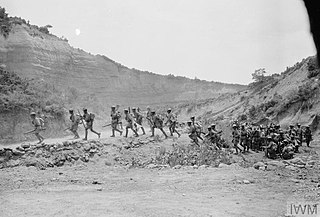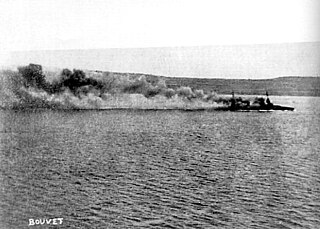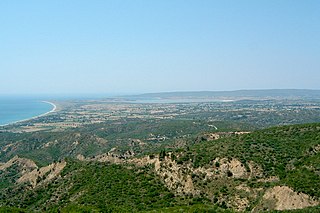 W
WThe second attack on ANZAC Cove was an engagement during the Gallipoli Campaign of the First World War. The attack was conducted by the forces of the Ottoman Turkish Empire, against the forces of the British Empire defending the cove.
 W
WThe third attack on Anzac Cove was an engagement during the Gallipoli Campaign of the First World War. The attack was conducted by the forces of the Ottoman Turkish Empire, against the forces of the British Empire defending the cove.
 W
WThe landing at Anzac Cove on Sunday, 25 April 1915, also known as the landing at Gaba Tepe, and to the Turks as the Arıburnu Battle, was part of the amphibious invasion of the Gallipoli Peninsula by the forces of the British Empire, which began the land phase of the Gallipoli Campaign of the First World War.
 W
WThe Battle for Baby 700, was an engagement fought during the Gallipoli Campaign of the First World War, between the forces of the British Empire and the Ottoman Turkish Empire.
 W
WThe landing at Cape Helles was part of the amphibious invasion of the Gallipoli peninsula by British and French forces on 25 April 1915 during the First World War. Helles, at the foot of the peninsula, was the main landing area. With the support of the guns of the Royal Navy, the 29th Division was to advance six miles (9.7 km) along the peninsula on the first day and seize the heights of Achi Baba. The British were then to go on to capture the forts that guarded the straits of the Dardanelles. A feigned landing at Bulair by the Royal Naval Division and a real landing at Anzac Cove were made to the north at Gaba Tepe, by the Australian and New Zealand Army Corps before dawn and a diversionary landing was made by French forces at Kum Kale on the Asiatic shore of the Straits. After dark another demonstration was made by the French in Besika Bay.
 W
WThe Battle of Chunuk Bair was a World War I battle fought between the Ottoman defenders and troops of the British Empire over control of the peak in August 1915. The capture of Chunuk Bair,, the secondary peak of the Sari Bair range, was one of the two objectives of the Battle of Sari Bair.
 W
WThe Battle of Gully Ravine (Zığındere) was a World War I battle fought at Cape Helles on the Gallipoli peninsula. By June 1915 all thoughts the Allies had of a swift decisive victory over the Ottoman Empire had vanished. The preceding Third Battle of Krithia and the attack at Gully Ravine had limited objectives and had much in common with the trench warfare prevailing on the Western Front. Unlike previous Allied attacks at Helles, the Gully Ravine action was largely successful at achieving its objectives though at a typically high cost in casualties.
 W
WThe Battle of Hill 60 was the last major assault of the Gallipoli Campaign. It was launched on 21 August 1915 to coincide with the attack on Scimitar Hill made from the Suvla front by Major-General H. de B. De Lisle's British IX Corps, Frederick Stopford having been replaced in the few days previous. Hill 60 was a low knoll at the northern end of the Sari Bair range which dominated the Suvla landing. Capturing this hill along with Scimitar Hill would have allowed the Anzac and Suvla landings to be securely linked.
 W
WThe First Battle of Krithia was the first Allied attempt to advance in the Battle of Gallipoli during the First World War. Starting on 28 April, three days after the Landing at Cape Helles, the defensive power of the Ottoman forces quickly overwhelmed the attack, which suffered from poor leadership and planning, lack of communications and exhaustion and demoralisation of the troops.
 W
WThe Third Battle of Krithia, fought on the Gallipoli peninsula during World War I, was the last in a series of Allied attacks against the Ottoman defences aimed at achieving the original objectives of 25 April 1915. The previous failures in the first and second battles resulted in a less ambitious plan being developed for the attack, but the outcome was another costly failure for the Allies. The allied aim was, as always to facilitate the capture of Alçı Tepe which commanded most of the peninsula.
 W
WDuring the Gallipoli campaign in 1915, several battles were fought near the village of Krithia which is from the Greek "Krithari" which means Barley. The village was an objective of the first day of the landing, 25 April 1915. Over the following months, invading British Empire and French troops, who had landed near Cape Helles at the end of the peninsula, made several attempts to capture the village. It was never reached; the Turkish defenders successfully repulsed every assault.
 W
WThe Second Battle of Krithia continued the Allies' attempts to advance on the Helles battlefield during the Battle of Gallipoli of the First World War. The village of Krithia and neighbouring hill of Achi Baba had to be captured in order for the British to advance up the Gallipoli peninsula to the forts that controlled passage of the Dardanelles straits. A small amount of ground was captured after two days of costly fighting but the objectives remained out of reach.
 W
WThe Battle of Kumkale was a World War I battle fought between the Ottoman defenders and troops of the France. It was a part of Gallipoli Campaign fought on the Anatolian (Asian) part of the Dardanelles Strait as a diversion from the main landings on the Gallipoli peninsula. Kumkale is the name of a village which now is a part of Troy national park.
 W
WThe Battle of Lone Pine was fought between Australian and New Zealand Army Corps (ANZAC) and Ottoman Empire forces during the Gallipoli Campaign of the First World War, between 6 and 10 August 1915. The battle was part of a diversionary attack to draw Ottoman attention away from the main assaults being conducted by British, Indian and New Zealand troops around Sari Bair, Chunuk Bair and Hill 971, which became known as the August Offensive.
 W
WThe naval operations in the Dardanelles campaign took place against the Ottoman Empire during the First World War. Ships of the Royal Navy, French Marine nationale, Imperial Russian Navy and the Royal Australian Navy, attempted to force the Dardanelles Straits, a narrow, 41 mi (66 km)-long waterway connecting the Mediterranean Sea with the Sea of Marmara and the Black Sea further north.
 W
WThe Battle of the Nek was a minor battle that took place on 7 August 1915, during the Gallipoli campaign of World War I. "The Nek" was a narrow stretch of ridge on the Gallipoli Peninsula. The name derives from the Afrikaans word for a "mountain pass" but the terrain itself was a perfect bottleneck and easy to defend, as had been proven during an Ottoman attack in June. It connected Australian and New Zealand trenches on the ridge known as "Russell's Top" to the knoll called "Baby 700" on which the Ottoman defenders were entrenched.
 W
WThe Battle for No.3 Post was fought during the Gallipoli Campaign in the First World War, between the forces of the New Zealand Mounted Rifles Brigade and the Turkish 19th Division.
 W
WThe landing at Suvla Bay was an amphibious landing made at Suvla on the Aegean coast of the Gallipoli peninsula in the Ottoman Empire as part of the August Offensive, the final British attempt to break the deadlock of the Battle of Gallipoli. The landing, which commenced on the night of 6 August 1915, was intended to support a breakout from the ANZAC sector, five miles (8 km) to the south.